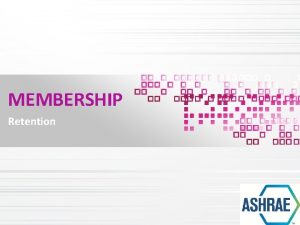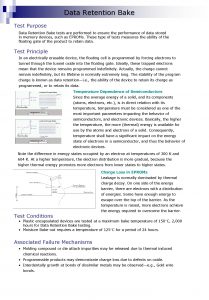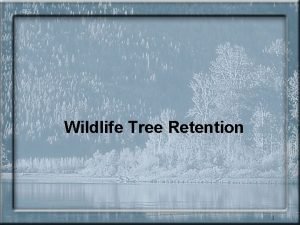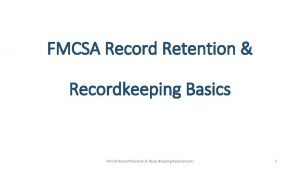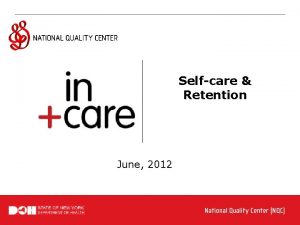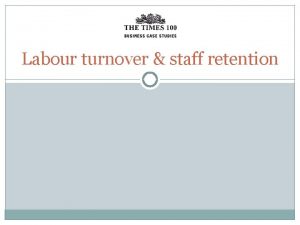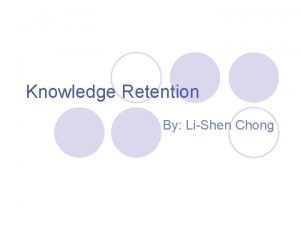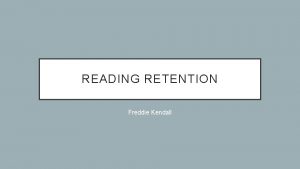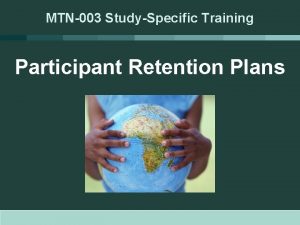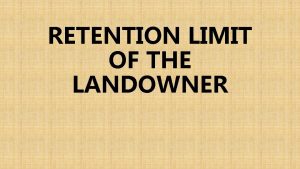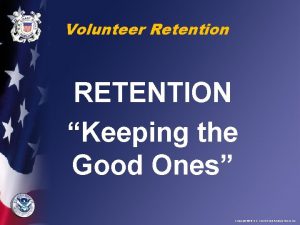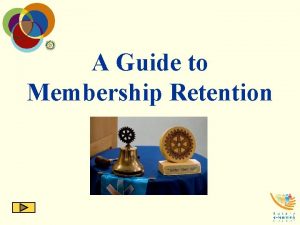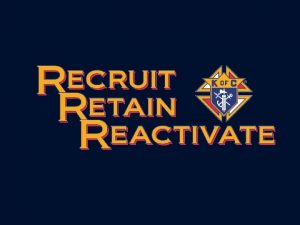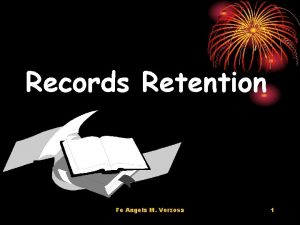OLD GROWTH RETENTION 1 Planning for Old Growth






































- Slides: 38

OLD GROWTH RETENTION 1

Planning for Old Growth Retention Goals – Spatially locate and map OGMAs based on – maximizing biological effectiveness within the constraints – Legally establish objectives for OGMAs 2

Acronyms CFLB = Crown forested land base THLB = timber harvesting land base NC = non-contributing land base OGMA = old growth management area BEC variant = biogeoclimatic variant TSR = timber supply review SDM = statutory decision maker WTR = wildlife tree retention 3

Planning for Old Growth Retention Data Preparation Develop OGMA Targets Develop WTR Targets Delineate OGMAs Write LU Objectives Legally establish LU Objectives 4

Data Preparation Classify the landscape unit data set to: – prepare old growth retention report (table 2. 8) – produce colour themed maps 5

Definitions 6

Forest polygons 7

Data Preparation - old growth retention report (table 2. 8) • provides an overview of all LUs in a planning area by BEC variant – % old growth in NC to meet old growth target – % old in THLB available to meet targets, if required – % almost old in NC and THLB to meet targets, if required – % old an almost old in the constrained THLB – % of THLB that meets minimum harvest age • allows for monitoring 8

Old Growth Retention Report (Table 2. 8) 9

Planning for Old Growth Retention Data Preparation Develop OGMA Targets Delineate and Assess OGMAs Develop WTR Targets Write LU Objectives Legally Establish LU Objectives 10

Planning for Old Growth Retention STEPS Step 1: Prepare OGMA targets report (accounting) Step 2: delineate draft OGMAs (design) Step 3: assess draft OGMAs 11

Planning for Old Growth Retention Step 1: OGMA targets Report Biodiversity emphasis Old growth target Existing OG in NC Existing OG in THLB -----------------NC OGMA Target THLB OGMA Target Recruitment OGMAs Based on Table 2. 8 determined based on rules 12

Table 3. 1. OGMA Targets (ha) Report 13

Step 1: OGMA targets Biodiversity emphasis affects OGMA targets: Intermediate and high biodiversity emphasis – establish objectives to meet entire OGMA target immediately – develop and establish recruitment OGMAs 14

Step 1: OGMA targets Low biodiversity emphasis – draw down to 1/3 of the OGMA target, unless target met completely in NC or timber supply analysis indicates no impact or an established HLP directs otherwise – develop recruitment strategy that meets entire OGMA target by the end of three rotations 15

Table 3. 1. OGMA Targets (ha) Report Biodiversity Emphasis Old Growth Target Existing OG in NC Existing OG in THLB I L 2000 1000 500 ---------------------------------OGMA Target NC OGMA Target THLB Recruitment OGMAs 1000 500 1000 16

Planning for Old Growth Retention STEP 2: Delineate OGMAs Information required : – OGMA Targets Report (Table 3. 1) – colour themed maps (from Data Preparation process) – relevant higher level plan direction (e. g. RMZ objectives) – strategic land use plans (LRMPs, KBLUP, CCLUP) – RLUPS priorities – approved operational plans – air photos, ortho-photos, satellite images 17

Biological considerations - 1 Review “old” or the oldest available stands first No single “correct” way of addressing biological considerations to be included in OGMAs Primary biological considerations (core values): – size (interior/no interior habitat) – connectivity – species composition – representation/rare ecosystems 19

Biological considerations - 2 Don’t do the same thing everywhere Consider 3 spatial scales: – stand – single LU – larger landscape Consider likely longevity of the patch in context of the landscape over time 20

Biological considerations - 3 Larger patches have interior habitat Smaller habitats dominated by edge effects Interior habitat & edge effects also influenced by shape of the OGMA Consider what is needed -- several small OGMAs OR fewer large OGMAs (up to target) 21

Biological Consideration - 4 Representation is a core concept in conservation biology -- “keeping all the pieces” Representation within policy constraints -- but note significant gaps – generally restricted to variant due to timber impacts Try to capture the range of old forest ecosystems within OGMAs 22

Biological consideration - 5 Rare by there very nature means they are not common, however contain unique biodiversity values. Where rare old forest site series are known and mapped include them in OGMAs If rare is not known, reserve some of old growth budget to deal with them – use forest cover maps, local knowledge and CDC information to locate potentially rare ecosystems 23

Biological considerations - 5 Connectivity: Try to accommodate -- but no extra budget. Considerations: – Consider regional connectivity – Maintain linkages for movement, e. g. , low passes in otherwise mountainous/steep terrain – Distance between older patches (relates to probability of moving between patches) – Stand structure can increase “connectivity” 24

Delineating OGMAs - Biodiversity Considerations OGMA targets: NC 200 ha THLB 500 ha 25

Step 2: Operational Considerations Minimize impacts to forest licencees by: – where suitable, use most constrained THLB first – avoid locating OGMAs over approved category A cutblocks (exception - known rare ecosystem) – avoid locating OGMAs where they will impact main access routes or isolate harvestable timber 26

Operational Considerations - 2 Operational activities permitted in OGMAs which should proceed in a manners sensitive to old growth values: – mineral or gas exploration and development activities – range use – haul road construction (only if no other reasonable and cost effective options exist) 27

Operational Considerations -3 OGMAs are intended to be areas where commercial harvesting is normally prohibited If operational activities are required, proceed sensitive to old growth values If operational activities significantly impact old growth attributes, OGMA location should be reassessed. 28

Delineating OGMAs–Operational Considerations OGMA targets: NC 200 ha THLB 500 ha 29

Delineate OGMAs Summary of Steps Determine old growth targets by variant for THLB and NC Assess all potential patches (considering all BECs together) Determine primary biological considerations – Ideally, ground-truth “old” attributes of potential OGMAs – Record presence of features/attributes (for each patch for ranking and future reference) 30

Delineate OGMAs Summary of Steps - 2 Rank potential OGMAs Design to balance OGMA biological values with operational considerations 31

Step 2: Delineate OGMAs Recruitment occurs where not enough existing old forest available to meet targets - applies to both NC and THLB - use the biologically best NC or THLB when recruiting. 32

Step 2: Delineate OGMAs Recruitment Developing recruitment strategies Immediate recruitment – below old growth target in intermediate or high emphasis – below 1/3 old growth target in low emphasis Recruitment over 3 rotations – applies to low biodiversity emphasis LUs 33

Step 2: Delineate OGMAs Recruitment Locating recruitment OGMAs: – follow biodiversity and operational considerations – consider suitable (I. e biologically equivalent) younger forest in the NC prior to impacting the THLB – high and intermediate emphasis LUs – choose forested areas that will maximize biodiversity conservation values in the shortest possible time frame 34

Planning for Old Growth Retention Step 3: Assess OGMAs Prepare tabular summary of OGMAs by Landscape Unit: (Table 3. 2) – document actual OGMA placed in NC and the THLB – document recruitment OGMAs – documents priorities for OGMA establishment Develop a data base to track individual OGMA and their attributes – documentation of biodiversity attributes captured in each OGMA 35

OGMA exercise Group Exercise – 4 - 5 people/group Materials – a set of various colour-themed maps – LUPG chapter 3 – Workbook/handout 37

OGMA exercise Time – 1 hour basic exercise, 30 - 45 minutes to report out/discuss – 30 minutes to assess wildcards, 30 minutes to report out 38

OGMA exercise Purpose To carry out the ‘accounting step’ - calculate the old growth targets for the NC and THLB To think about the ecological and operational considerations (included in the LUPG), when locating OGMAs To promote group discussion and group solutions regarding options for OGMA locations To delineate OGMAs up to the target level 39

OGMA exercise Wild Cards will add a few complications to the scenario once you have completed the basic exercise as defined in the workbook/handout – IWMS – rare ecosystems – category A approved cutblocks 40
 Human resource planning and retention
Human resource planning and retention Fspos vägledning för kontinuitetshantering
Fspos vägledning för kontinuitetshantering Typiska novell drag
Typiska novell drag Nationell inriktning för artificiell intelligens
Nationell inriktning för artificiell intelligens Ekologiskt fotavtryck
Ekologiskt fotavtryck Varför kallas perioden 1918-1939 för mellankrigstiden
Varför kallas perioden 1918-1939 för mellankrigstiden En lathund för arbete med kontinuitetshantering
En lathund för arbete med kontinuitetshantering Kassaregister ideell förening
Kassaregister ideell förening Tidbok yrkesförare
Tidbok yrkesförare A gastrica
A gastrica Vad är densitet
Vad är densitet Datorkunskap för nybörjare
Datorkunskap för nybörjare Stig kerman
Stig kerman Hur skriver man en debattartikel
Hur skriver man en debattartikel Delegerande ledarskap
Delegerande ledarskap Nyckelkompetenser för livslångt lärande
Nyckelkompetenser för livslångt lärande Påbyggnader för flakfordon
Påbyggnader för flakfordon Lufttryck formel
Lufttryck formel Svenskt ramverk för digital samverkan
Svenskt ramverk för digital samverkan Kyssande vind analys
Kyssande vind analys Presentera för publik crossboss
Presentera för publik crossboss Vad är ett minoritetsspråk
Vad är ett minoritetsspråk Bat mitza
Bat mitza Treserva lathund
Treserva lathund Fimbrietratt
Fimbrietratt Claes martinsson
Claes martinsson Centrum för kunskap och säkerhet
Centrum för kunskap och säkerhet Byggprocessen steg för steg
Byggprocessen steg för steg Mat för idrottare
Mat för idrottare Verktyg för automatisering av utbetalningar
Verktyg för automatisering av utbetalningar Rutin för avvikelsehantering
Rutin för avvikelsehantering Smärtskolan kunskap för livet
Smärtskolan kunskap för livet Ministerstyre för och nackdelar
Ministerstyre för och nackdelar Tack för att ni har lyssnat
Tack för att ni har lyssnat Referat mall
Referat mall Redogör för vad psykologi är
Redogör för vad psykologi är Matematisk modellering eksempel
Matematisk modellering eksempel Tack för att ni har lyssnat
Tack för att ni har lyssnat Borra hål för knoppar
Borra hål för knoppar







































